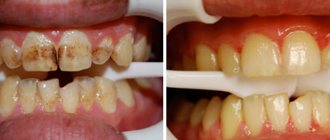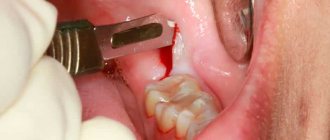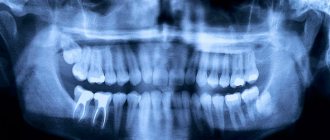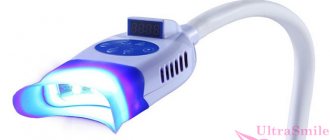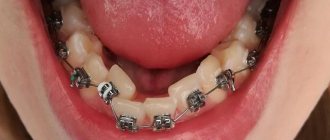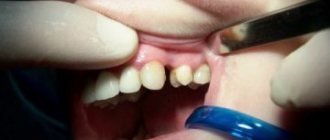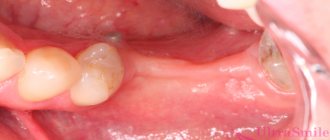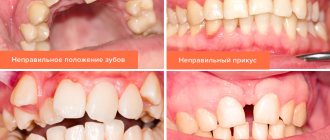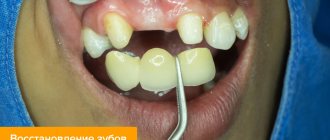Today, the obvious fact is that the level of quality of dental treatment has increased significantly. What affects the quality and long-term treatment is sometimes hidden from the patient’s eyes or he does not attach importance to it. For example, in this article we want to talk about the use of such an auxiliary element in treatment as a rubber dam. It also has other names used: optidam or rubberdam. Sometimes it may seem to the patient that the dental clinic uses such “add-ons” in order to make the treatment procedure more expensive. Believe me, this is absolutely not true. Below we will tell you why the use of a rubber dam in treatment is indispensable if you want to receive high-quality treatment with long-term results.
Cofferdam - what is it and why is it used in dental treatment?
Treatment of dental diseases requires increased attention and concentration on the part of not only the doctor, but also the patient himself. To make this process as simple, fast and painless as possible, specialists use many different devices, one of which is a rubber dam. This is a small latex pad with which the doctor isolates the treated area from the moist environment of the oral cavity. Read further in our article about why a rubber dam is needed in dentistry and how to use it correctly.
Rubber dam in pediatric dentistry.
Rubber dam in pediatric dentistry. Probably many have heard the sonorous name Cofferdam or Rubberdam , Dentaldam . What kind of Know-how is this you might inadvertently think? But everything is simpler than it seems! A rubber dam (also known as a “teeth scarf”) is a latex curtain that separates the teeth undergoing treatment from the oral cavity.
Rubber dam is a way to completely isolate teeth while the doctor is working!
It may seem that this invention appeared quite recently, but in fact it was the American Sanford C. Barnum who first proposed the use of a rubber curtain to isolate the working field about 150 years ago.
“Any manipulation by a dentist in the oral cavity should be considered by patients as a surgical intervention. As in general surgery, isolation of the surgical field is necessary, even if a routine filling is performed!”
In dentistry, the use of a rubber dam provides the following advantages: 1. The patient is protected from swallowing and, worse, inhaling a small instrument , a piece of natural tooth tissue, fragments of old fillings, aggressive solutions or other irritating substances.
2. The patient is protected from injury from rotating instruments. This is a very important advantage since the bur located in the handpiece rotates at speeds of up to 300,000 rpm. Now imagine how unpleasant it will be if this bur touches the cheek or tongue of not only a small child, but also an adult. to the gums, tongue and buccal mucosa by chemicals is excluded 4. Protecting the tooth from saliva. Why is this so important? The fact is that saliva contains more than 700 types of different bacteria, and when saliva gets into a tooth prepared for filling, they spread through the dentinal tubules into the pulp (popularly called the nerve), which entails serious complications. 5. The doctor has the opportunity to perform his operations in a clean, isolated field , which provides excellent visibility and concentration. I think you'll agree with me that you work better with what you see. 6. Less waste of time. There is no need to rinse your mouth every five minutes and change cotton swabs. Even if the doctor “stuffs” your mouth full of cotton wool, this does not completely isolate the tooth! When placing a filling with a kilogram of cotton wool in the mouth, the moisture contained in the exhaled air safely gets onto the surface of the tooth and after 3-4 years (or even earlier) we get this: There will be a violation of the marginal seal of the filling, i.e. the filling is just will settle...
7. The doctor and assistant are protected from infection , which can be transmitted through the patient’s saliva or oral fluid. 8. Psychologically, patients feel more comfortable , since they do not feel that their mouths have been “caught” with hands and instruments.
The Cofferdam system consists of the following components: 1) Latex scarves or latex curtains are special elastic disposable scarves made from natural latex; in some cases (for example, latex allergies) curtains are produced with a reduced latex content and do not contain latex; instead, they are used silicone or polyvinyl chloride. Scarves come in different thicknesses and different colors - blue, light blue, green, pink, beige and even black. To eliminate the smell of rubber, scented scarves with the smell of fruit or mint are produced. We, pediatric dentists, call it the “magic blue (green) raincoat”, “cozy blanket”.
2) Clamps for fixing a scarf on a tooth are special spring clips for holding a scarf on a tooth. The clamps are made of plastic and made of stainless biocompatible steel. The clamp is a kind of ring that firmly covers the tooth on both sides. All clamps, without exception, are subject to disinfection and sterilization (exposure to hot steam). For a child - a “magic ring” or “a crown for a beautiful princess, prince.”
3) The forceps are designed for installing the clamp on the tooth. These are special pliers with protrusions at the tip that fit into the holes on the clamps and hold them.
4) The punch makes a hole in the latex scarf. The doctor himself chooses what size hole to punch in accordance with the size of the tooth, i.e. if the tooth is small, then the hole in the scarf will be small and vice versa.
5) The frame for the scarf serves to hold this entire structure, i.e. scarf with a clip.
This is what the installation of the rubberdam system looks like step by step at a dentist’s appointment. Step 1 - first, a hole is made in the latex scarf in accordance with the size of the tooth that needs to be isolated. Step 2 - the clamp is tried on in a latex curtain. Step 3 - using special forceps, the clamp is installed together with a latex scarf on the desired tooth. Step 4 - fixing the frame. All dentists know very well what the advantages of treatment with a rubber dam are. It helps create the most sterile conditions for the doctor, preventing saliva from entering the tooth cavity and protecting the mucous membranes from small particles, water and aggressive solutions. But all this is convenient, first of all, for us – dentists. But sometimes it can be very difficult to explain to a small child why a rubber trampoline is pulled in his mouth, and especially since the whole structure will be “gently” hugged and supported by a “magic ring”. That's why I turn to you, dear parents! Pediatric dentistry must first and foremost be of high quality. Not only the doctor, but also the patient must keep up with the times and new technologies. And you, like no one else, must help your child and the doctor in this difficult matter. We definitely need your support! Don’t be lazy, talk to your child on the eve of the upcoming treatment, this will greatly help the doctor set him up for positive contact. Tell him a fairy tale about a “magic blue cloak” or a “cozy blanket” that will envelop your tooth and help him “fall asleep” faster; or that a real “crown” will be put on the tooth, and the child will try it on and choose it himself. After all, there are no limits to our fantasies! Let's together protect, protect, and support the fragile world of a child!
FAQ. 1) Does it hurt to install a clamp (ring) on a tooth? No, because before this, anesthesia (freezing) is carried out and when the clamp (ring) is put on the tooth, patients do not feel anything. However, you need to understand that if the tooth is severely damaged or has not fully erupted, then the gums may be injured, but this is only a temporary inconvenience and the gums will recover on their own within 2-3 days. 2) How long does it take to install a rubber dam? On average, under ideal conditions (the child is very sociable and willingly agrees to everything at once), placing a rubber dam will take about 3-5 minutes, but you must understand that this is an approximate time and children are completely different, in most cases it takes time for the child to adapt and getting to know the magic handkerchief on a plastic model in a playful way. 3) How does a child (adult) breathe and swallow saliva? The rubber dam does not affect breathing difficulties in any way, so you can calmly breathe through your nose and swallow saliva. In some cases, there is difficulty swallowing saliva, but a special aspirator will quickly correct this problem. 4) What to do if a child (adult) has a gag reflex? The gag reflex is not a death sentence, but in order to cope with this problem, an integrated approach is needed, namely psychological preparation; with a rubber dam it will be easier to adapt to the upcoming manipulations and there will be no feeling that they have been “caught” with hands and instruments in their mouth.
The article uses illustrations from the favorite book “Endodontics” Volume 1 “Tooth Isolation: the Rubber Dam” by Arnaldo Castellucci, as well as photographs of talented dentists
Cofferdam - why latex insulation is needed
The device is a latex napkin fixed on a frame or a special plastic rim. The product is used to isolate the working field during dental procedures. A hole is made in the material corresponding to the size of the tooth that is planned to be treated. Then the napkin is applied to the dentition, and only the desired tooth remains in open access, while all others, including soft tissues, do not come into contact with the working area.
What is a rubber dam?
Thus, answering the question of what a dental dam is for, it is important to note that such a film helps prevent contact of the treated tissues with saliva, blood and other liquids that are naturally released in the oral cavity and can reduce the quality of treatment results. This type of isolation was invented back in 1864, and to this day it is actively used in dental practice - today the use of rubber dam as part of the treatment of dental diseases is a mandatory condition of the International Standard1.
Rubberdam. New quality standard?
Rubber dam in dentistry.
For many patients, the word rubber dam or rubber dam (synonyms) is new. What kind of device is this and why does the dentist use it? This is what today's article is about.
It’s no secret that dentistry has taken a noticeable “step forward” over the past few years. New technologies are replacing old ones, new companies are entering the market, equipment is being improved, materials are becoming more aesthetically pleasing and durable. There is a lot of money in dentistry (despite the crisis), so progress is inevitable and that’s great. On the one side. On the other hand, such a rapid change of generations of “equipment” requires the doctor to keep his finger on the pulse all the time, monitor the latest events, trends, and know how to apply these innovations in his practice in order to make it better . And do no harm.
Composite materials (composite “ light fillings ”) appeared in our country in the early 90s, if I’m not mistaken, and the use of composites began to gradually become widespread. Why did it happen so?
Before composites, teeth were filled with cements (phosphate, glass ionomer, etc.) or amalgam . These are good materials that have proven themselves, but cements and amalgam had a number of disadvantages, which subsequently led to the transition of most dentists to composite materials. It was difficult or impossible to model anatomy with cements; some of them caused toxic and thermal effects on tooth tissue during “hardening”; it was necessary to make some kind of insulating and “therapeutic” “gaskets”. Amalgam was also not completely biocompatible and easy to use (not to mention aesthetics). In addition to all this, the materials of the “past generation” required classical preparation; usually, for this, the doctor had to excise not only caries, but also healthy tissue in order to create retention points to hold such a filling. All undercuts (overhanging edges) were also ordered to be eliminated - otherwise there was a high risk of fracture.
Why are dentists happy to switch to “light fillings”? Firstly, of course, aesthetics . Nobody wants a metal filling, everyone wants a “white” one :) Secondly, compared to amalgam and cements, it was much easier to work with a composite. There is no need to mix or knead anything, the consistency of the composite made it possible to model it as much as you wanted, and then “illuminate” it with a lamp and the filling is ready! You don’t need to wait 2 hours to eat, the filling is beautiful, you don’t need a second visit for polishing, as with amalgam. All in all, a fairy tale.
But not everything turned out to be so simple. In addition to the composite itself, this technique of filling (restoring) teeth also uses an adhesive system . Her role was greatly underestimated by dentists, because... this has never been done before. In simple terms, the adhesive system is the “glue” that “sticks” the composite filling to the surface of the tooth tissue. This “glue” has a very complex chemistry (and over the years it becomes more and more complex) and the process of “gluing” the filling to the tooth is influenced by many factors. And one of the main factors is the cleanliness of the working area. That is, the absence of any “polluting” factors (blood, saliva, food plaque, etc.), including moisture. In order for the “seal” to “stick”, it must not only be clean, but also dry . Otherwise, the fillings “fall out”, “darken”, teeth hurt after treatment, thin walls break, etc. With proper adhesive restoration techniques , the tooth does not need to be over-prepared to create “retention points” and “additional sites” to “hold” the filling in place. This is a big advantage of composite materials, coupled with their biocompatibility and aesthetics. But often doctors “ don’t believe ” in adhesion (gluing) and prepare teeth “the old fashioned way,” as for cement or amalgam fillings. But that's half the trouble . If the conditions for carrying out the adhesive restoration technique are violated, the composite often behaves worse than cements and amalgam, which leads to complications even faster than in the case of using “old materials”. Pain after treatment, “falling out” fillings, wall fractures, secondary caries - this is most often the result of a violation of the technique of using the composite and the adhesive system. After the emergence of many complications, many doctors even became skeptical about composite restorations.
Great introduction. But without it, you would not be able to fully appreciate the significance of such a simple, but at the same time irreplaceable device as a rubber dam.
Rubberdam (eng. rubber - rubber, dam - barrier) is a system for isolating the working field in dentistry. Rubber dams are latex scarves that are fixed to the teeth with special metal clamps, “ clamps .” Oddly enough, rubber dam is not a newfangled “gadget” in the dental market. The technology is quite old and is already almost 150 years old ! This system was invented by the American dentist Sanford Christie Barnum in 1864. Why are we returning to this technology now? And why was she “forgotten”? The answer lies in my voluminous introduction. The reason is a change in technology . Rubberdam, which appeared on the market a century and a half ago, was very popular among dentists, but its popularity gradually faded away, because... The rubber dam had an indirect effect on the outcome of tooth filling, and required effort, time and financial costs for installation. Therefore, the rubber dam was used by a small number of doctors (in general, as it is now, unfortunately) and only for endodontic treatment. Now this isolation technique has again become in demand with the advent of adhesive technology for dental restoration and adhesive fixation of ceramic restorations, because adhesion is more demanding on the cleanliness of the working field.
In addition to ensuring absolute dryness of the working field, the rubber dam also prevents contamination (infection) of tooth tissues by oral microorganisms, which is of no small importance in root canal treatment. If you go for an X-ray of a tooth during treatment (with instruments or to check the filling of canals) without a rubber dam , saliva inevitably gets into the tooth and root canals, and with it, possibly, food plaque, which contains tons of microorganisms. This does not always lead to negative consequences, because... our body is a perfect system that is quite difficult to damage irreparably, but in combination with other factors, this can lead to chronic inflammation, destruction of bone tissue and ultimately even tooth loss . Cleanliness is the key to health. This also applies to root canals, oddly enough :)
not all agree that the use of rubber dam in endodontics is justified , but far fewer dentists agree in the treatment of caries They are more willing to believe in miraculous “healing pads” (which, I am sure, are not necessary) than in the advisability of isolation. But in my opinion, the use of rubber dam in the treatment of caries is more than justified , because dentin has a “porous” structure, and can also be easily infected by microorganisms, and this is an important factor when the cavity in the tooth comes quite close to the pulp chamber (deep caries, so-called).
All of the above applies to the treatment of children . But rubber dams in pediatric dentistry are the exception rather than the rule, unfortunately. It’s not customary for us to bother with primary teeth, and if a child has already erupted permanent teeth and they have caries, then at the “children’s appointment” there is usually no time for a rubber dam\it’s not necessary\I don’t know how/the child can’t handle it, etc. d. Hence the problems with teeth and bite at the age of 18-25 years, because most often the chewing teeth (first molars, “6s”), which erupt first, are affected, and these are the “keys of occlusion,” the most important teeth for full chewing. They are the first to be removed at a young age, most often.
Fortunately, more and more doctors (especially young ones) are beginning to use the rubber dam system to isolate teeth. This undoubtedly improves the culture and efficiency of our treatment. Rubber dam is a simple and affordable tool that every specialist involved in the treatment and reconstruction of teeth must own. It is not surprising that the rubber dam is accepted as a quality standard in the world's recognized dental communities. Rubber dam is not only a necessary standard for daily practice and improves the quality of treatment, but also comfort for both the doctor and the patient. Many doctors who do not use rubber dams say that it is “inconvenient” for their patients. But my daily practice (as well as research by scientists) shows the opposite: 99 patients out of 100 are absolutely not against a rubber dam, moreover, many even feel more comfortable with it.
The benefits of using a rubber dam are simple and clear. Why then do most doctors not use it in their daily practice at all, or use it on major holidays? The answer is quite simple: laziness and unwillingness to work better today than yesterday. Think about this when choosing your doctor and your child's doctor.
I hope in this article I was able to clearly talk about the “new old technology” called rubber dam, what it is needed for and when it is used. Thank you for your attention! Health to you and your teeth! :)
Khaldin Alexander Sergeevich
What useful qualities does the product have?
The use of such a protective pad can significantly simplify the specialist’s work and make the treatment as high-quality as possible. The dentist does not need to be distracted by replacing cotton swabs or removing excess fluid - nothing interferes with him in order to fully concentrate on treating the causative tooth. In addition, working with a rubber dam is the key to achieving a high-quality and durable result, because in such isolated conditions neither saliva nor blood disrupt the adhesion strength of the material to the tooth.
As for patients, they also receive tangible benefits if the doctor uses a rubber dam during the treatment process. Here are some of the main benefits:
- quality work done and guaranteed long-term results are an undeniable plus not only for the doctor, but also for the patient. The seal will remain firmly in place for as long as it should
- preventing filling material and medications from getting into the throat and mucous membranes in general,
- reducing the risk of developing allergies, since the drugs and solutions used come into direct contact only with the selected area,
- the ability to swallow saliva normally during treatment,
- reduced discomfort - the mucous membrane dries out less, and the patient does not have to make an effort to keep his mouth open for a long time,
- prevention of the gag reflex, which often occurs in patients when the dentist places cotton rolls.
This material allows you to isolate the treatment area.
The device in question greatly simplifies the doctor’s work, and therefore saves time for him and the patient. Treatment with it goes quickly, and you don’t have to worry about the results obtained.
Contraindications and disadvantages.
- If a person has impaired nasal breathing, the use of a rubber dam is contraindicated, since the patient will not be able to breathe normally. Also, the use of rubber dam is not applicable for people with Alzheimer's disease, with epileptic seizures, provided that there is an allergy to talc, rubber or latex. In case of allergic reactions, special sponges and rollers are used to absorb moisture; a saliva ejector also helps to cope with the secretion of saliva. But these measures do not provide such high-quality isolation of the tooth being treated and the service life of the filling is significantly reduced.
- If the doctor is not highly qualified, then when using a rubber dam there is a risk of damage to the interdental papillae.
- To install a rubber dam, it is necessary to work “with 4 hands”, that is, the doctor works in tandem with an assistant.
- Relative disadvantages also include a slight increase in the cost of the treatment procedure. But, taking into account the prospect of a long service life of the filling and high-quality canal filling, the use of a rubber dam makes treatment cheaper.
- The process of installing a rubber dam is often not a very pleasant procedure. But, taking into account further greater comfort during the treatment process: shorter time, less tired facial muscles, no penetration of medications and tissues of the treated tooth into the oral cavity, the discomfort from the installation can be considered minimal.
Yana Dmitrievna Mitskevich
Dentist, therapist
10
years of experience
All types of therapeutic treatment, including endodontic treatment using a microscope, microprosthetics, hygienic procedures of any degree of complexity.
Make an appointment
Does the device have any disadvantages?
Despite such an impressive list of advantages, rubber dams are also characterized by some negative aspects. So, for example, in very rare cases a patient develops an allergic reaction to the material. In other situations, the doctor may accidentally damage the interdental papillae, but this only happens if the technique of applying the rubber dam is violated. In addition, today in dentistry there are quite a few types of insulating onlays, which allows you to choose the material that is optimally suited for each specific case.
The patient receives many benefits when using a rubber dam.
In addition to the fact that with this device the patient can count on high-quality treatment, he also receives a set of other advantages:
- medications and particles of material do not enter the mouth and throat: isolation implies two-way tightness. On the one hand, the doctor protects the area of manipulation from the accumulation of saliva and moisture, hermetically seals adjacent teeth, gums and soft tissues. On the other hand, the patient can protect himself from accidental ingestion of foreign materials,
- reducing the risk of an allergic reaction: when treating pulpitis and periodontitis, patients often experience mucosal allergies to the application of the drug. Here contact with him will be strictly limited,
- comfortable treatment: rubber dam eliminates the need to use various cotton swabs, which means the patient will be relieved of the gag reflex. He will also be able to calmly make swallowing movements, without fear that soft tissues unrelated to treatment will be injured or damaged by the instrument. In addition, he will not have to strain his jaw and muscles in order to keep his mouth open throughout the entire period of treatment, since the device also acts as a kind of support,
- this saves your time: the doctor will not be distracted by additional manipulations, which means you will leave the office much faster than otherwise.
During treatment, the risk of swallowing the medicine is eliminated
In what situations do you use a rubber dam?
The protective lining is recommended for use in most dental procedures. All of them can be divided into three main groups:
- canal treatment: when it comes to root canal treatment, it is necessary to ensure perfect dryness and isolation - the success of the treatment largely depends on this,
- filling and restoration: usually a rubber dam is used when using light-curing materials,
- whitening: sometimes specialists use isolation during professional enamel whitening, but this is not always justified.
Rubber dam is used for various methods of dental treatment and restoration.
Thus, such an onlay can be used for almost any type of dental treatment. The choice of the type of rubber dam system directly depends on the planned procedure.
Scope of application of rubber dam.
- Endodontic dental treatment . When treating root canals, it is extremely important not only to maintain ideal sterility for the tooth, but also to prevent accidental contact with the oral mucosa of medications that can cause an allergic reaction.
- Restoration of teeth with light-curing fillings and artistic restorations. In order to achieve reliable adhesion of the filling material to the tooth surface, the conditions of absolute dryness of the treated surface must be met, which the rubber dam invariably helps with.
- Teeth whitening. To ensure that the whitening composition, which affects the enamel, does not injure the mucous membrane, the gums must be isolated using a liquid rubber dam. Professional teeth whitening is not complete without the use of a rubber dam.
- Fissure sealing. For high-quality fissure sealing (coating the chewing surface of the tooth with a special composition in order to protect the enamel from destruction by caries), a perfectly dry tooth surface is necessary.
- Splinting of teeth. When splinting, the adhesive material adheres better to the enamel surface when the risk of accidental saliva ingress is eliminated.
What are the restrictions on use?
Despite such a wide range of applications, the material also has contraindications. Dental experts identify two main limitations to its use:
- difficulty breathing through the nose - with such latex insulation you will not be able to breathe through the mouth,
- allergy to the material and its components.
The last problem is easily solved - you just need to warn your dentist in time about the presence of this contraindication. In this case, the doctor may suggest one of the suitable types of rubber dam.
Types of material
The product can be made in different colors, have different thicknesses and parameters. Below are the key differences between the different types of latex insulation:
- form: today specialists more often resort to using plates, although some manufacturers produce an insulating gasket in the form of a roll, in which case the doctor will have to independently adjust the required size. In addition, the pad can have different shapes for ease of use,
- thickness (from 0.13 to 0.39 mm): thin plates are more suitable for working with molars, while when restoring the smile area it is recommended to use the thickest plates. The medium thickness is universal, suitable for almost any area of the jaw system,
- color: almost transparent or light beige insulating napkin helps to better assess the position of the causative tooth. Green and blue colors are suitable for filling with light-curing materials. But in order to determine the tone of the enamel, they resort to using brown or gray latex.
There are also other types of rubber dam for individual cases. So, for example, it is possible to order material without the addition of talc or even without silicone - the best option for allergy sufferers.
Color and size variety
Rubber dams are divided depending on thickness and color range. The light beige color is good for endodontic treatment, but is not recommended for use with composites as it is colorless and may cause contour problems. Brown or gray is a more suitable option.
To have a clear and contrasting outline, a green curtain is suitable. This color does not reflect, smells pleasantly of mint and is tactilely pleasant for patients. Silicone dental tissues also come in light pink, purple, blue, and blue.
Some patients may experience allergic reactions to added substances (talc) in rubber or latex. For this purpose, optidam was created without talc, which does not cause allergies.
The following types of latex oral scarves are distinguished by thickness:
- a thick special one (0.34-0.39 mm) is needed if strong tissue protection is needed;
- extra thick (0.29-0.34 mm) is used for gum retraction;
- thick (0.33-0.38) is used for the same thing as extra thick;
- medium (0.18-0.23 mm) and thin (0.13-0.18 mm) are needed for standard treatment, they are easy to use and stretch well - this type is used only in initial practice, then they move on to more practical types.
Features of use
Installing and fixing a rubber dam for teeth is a simple procedure, but to carry it out the dentist needs the help of an assistant. It only takes a few minutes, but for a high-quality application of the protective lining you need to know some nuances. So, for example, the practitioner should hold the latex with the powdered side facing him while the smooth surface is applied to the oral tissue. The specialist chooses the method of installing the insulation himself, based on which tooth he will be working with and other features of the clinical picture.
Rubber dam is applied to the dentition
The material can first be attached to the frame using a special tool - forceps, and then the entire insulation system in its finished form is literally put on the tooth. In another case, the clamp, that is, a plastic frame, is first fixed on the tooth, and only then the rubber dam is placed.
“I understand perfectly well that the doctor needs this pad for the procedure to be successful. It is clear that the patient also receives only advantages from using the rubber dam. But on a personal note, I want to say that the process of putting it on your teeth is a very unpleasant topic. It’s good if the frost has time to set in, but in my case they didn’t inject anesthesia, so I felt everything perfectly…”
Anatoly G.P., Krasnoyarsk, from correspondence on the forum www.32top.ru
Learning how to properly attach insulation takes practice. Otherwise, this procedure does not present any particular difficulties for the dentist.
Advantages
This latex protection greatly facilitates the doctor’s work , as it allows him to clearly see the tooth. In addition, saliva or blood does not come into contact with the tooth, as a result of which microorganisms that can cause complications in the form of pain or repeated caries cannot penetrate into the working field. Also, the ingress of liquid reduces the likelihood of the filling sticking to the tooth, and the restoration period is short-lived even due to the moisture released during breathing.
What are the benefits of a rubber dam for patients?
Positive aspects of rubber dam in dentistry:
- safety, since the oral cavity is well protected from various solutions, sharp instruments and adhesive systems;
- the risk of developing allergies during treatment is significantly reduced;
- chewing muscles and joints get tired much less due to the need to keep the mouth open for a long time;
- the gag reflex decreases, because many patients cannot tolerate the presence of cotton rolls in the oral cavity;
- swallowing function is preserved;
- the patient experiences comfort, as it feels as if the treatment is being carried out outside the oral cavity;
- the support of the doctor’s fingers does not cause discomfort;
- the oral cavity does not dry out;
- A rubber dam helps well if the patient has anatomical features in the form of a large tongue or cheeks and the doctor needs to move or hold them;
- time is saved significantly, since there is no need to constantly rinse your mouth, spit out saliva or change cotton swabs.
When can you do without a latex pad?
In some situations, dental treatment can be carried out without the help of a rubber dam. Here are some of the cases when the insulation may not be fixed or it simply cannot be done:
- the presence of braces or a bridge in the mouth, under which film cannot be placed,
- anatomical features of the dental system,
- minor restoration and enamel whitening,
- working with the subgingival area, when the latex pad can only complicate the doctor’s manipulations,
- no assistant - installation must be done with four hands.
Modern dentistry offers other options for isolating the work area. For this purpose, ordinary cotton swabs, liquid rubber dam, tips, saliva ejectors and other devices can be used. All of them are characterized by their advantages and disadvantages, but they cannot become a complete replacement for a latex napkin. In any case, the dentist chooses the method of tooth protection based on the existing clinical picture, but taking into account the wishes of the patient.
- Borovsky E.V. Therapeutic dentistry. Textbook for medical schools, 2004.
Cofferdam is a material for isolating the working field
Just imagine: you came to the dentist with the goal of curing a tooth. Naturally, before this, he carries out a preparatory stage, during which he examines the cause of your complaints, diagnoses the problem and prepares for manipulation. To obtain a high-quality result, it is important that nothing interferes with the specialist, especially when it comes to root canal treatment, filling and restoration. It is for these purposes that he takes out the rubber dam. So what is it?
Cofferdam is a material for isolating the working field
This is a latex material or film that the doctor directly applies to the oral cavity and secures with a special frame and clamps. The film is created on the basis of juice extracted from the Brazilian Hevea plant, which is actively used in the rubber industry.
Next, the specialist makes a hole of the required size in the film. And puts the rubber dam on top of the tooth or group of teeth that are to be treated. This allows you to separate them from everyone else. In addition, the film ensures dryness in the affected area, eliminating the risk of saliva, pathogenic bacteria, blood, and breath fumes getting there (by the way, the doctor in this case is also protected from infection).
On a note!
If the doctor works without an assistant, then applying a rubber dam will be impossible, since the regulations of the International Protocol in Dentistry allow its correct installation only in four hands. Otherwise, there is a risk of incorrect positioning of the film and its displacement during operation.

